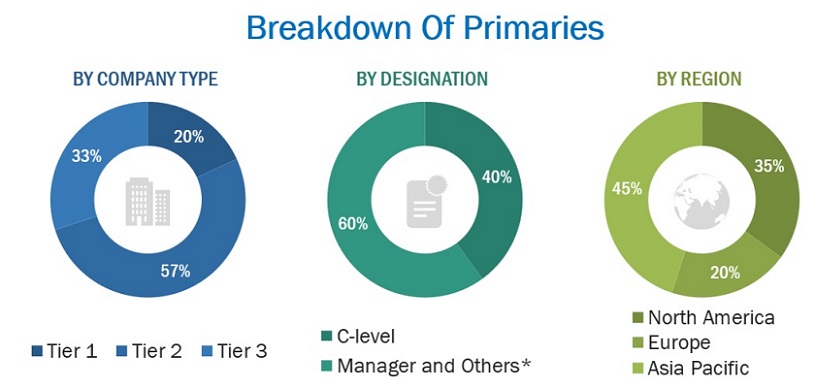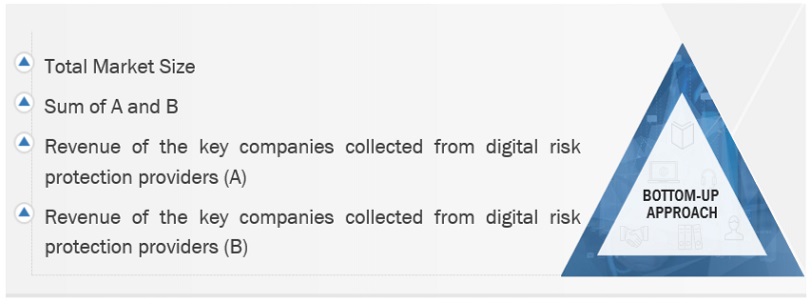The research study involved four major activities in estimating the digital risk protection market size. Exhaustive secondary research has been done to collect important information about the market and peer markets. The next step has been to validate these findings, assumptions, and sizing with the help of primary research with industry experts across the value chain. Both top-down and bottom-up approaches have been used to estimate the market size. Post which the market breakdown and data triangulation have been adopted to estimate the market sizes of segments and sub-segments.
Secondary Research
In the secondary research process, various secondary sources were referred to identify and collect information for the study. These included journals, annual reports, press releases, investor presentations of companies and white papers, certified publications, and articles from recognized associations and government publishing sources. Secondary research was mainly used to obtain key information about industry insights, the market's monetary chain, the overall pool of key players, market classification, and segmentation according to industry trends to the bottom-most level, regional markets, and key developments from both market and technology-oriented perspectives.
Primary Research
In the primary research process, various primary sources from both the supply and demand sides were interviewed to obtain qualitative and quantitative information for the report. The primary sources from the supply side included industry experts, such as Chief Executive Officers (CEOs), Chief Technology Officers (CTOs), Chief Operating Officers (COOs), Vice Presidents (VPs), marketing directors, technology and innovation directors, and related key executives from various companies and organizations operating in the digital risk protection market. The primary sources from the demand side included consultants/specialists, Chief Information Officers (CIOs), and subject-matter experts.

To know about the assumptions considered for the study, download the pdf brochure
Market Size Estimation
Multiple approaches were adopted to estimate and forecast the digital risk protection market. The first approach involved estimating the market size by summating companies' revenue generated through digital risk protection solutions.
Both top-down and bottom-up approaches were used to estimate and validate the total size of the market. The research methodology used to estimate the market size includes the following:
-
Key players in the digital risk protection market have been identified through secondary research.
-
Regarding value, the industry's supply chain and market size have been determined through primary and secondary research processes.
-
All percentage shares, splits, and breakups have been determined using secondary sources and verified through primary sources.
Market Size Estimation Methodology-Bottom-up approach

To know about the assumptions considered for the study, Request for Free Sample Report
Market Size Estimation Methodology-top-down approach

Data Triangulation
The data triangulation procedures were used to complete the overall market engineering process and arrive at the exact statistics for all segments and subsegments. The data was triangulated by studying various factors and trends from the demand and supply sides. Along with data triangulation and market breakdown, the market size was validated by the top-down and bottom-up approaches.
Market Definition
The digital risk protection market is experiencing exponential growth, catering to businesses seeking robust defenses against cyber threats. This sector offers multifaceted solutions encompassing the dark web and social media surveillance to preemptively detect references to a company or its brand, thereby averting potential reputational damage and security breaches. Additionally, these services extend to identifying and eliminating instances of unauthorized replication of a company's intellectual property, safeguarding its innovations and assets. Moreover, in the event of security incidents, these platforms facilitate swift and effective response strategies, mitigating the impact of breaches and enhancing overall cybersecurity posture. The market presents a comprehensive suite of tools and services essential for modern enterprises to combat the evolving landscape of cyber threats proactively.
Key Stakeholders
-
Enterprise and Corporations
-
Technology Partners
-
Third-Party Vendors
-
Digital Risk Protection providers
-
Regulatory Bodies and Government agencies
-
IT Security Teams
-
Legal advisors
-
Financial Institutes and Insurance Companies
-
Cybersecurity Firms
-
Educational and healthcare organizations
-
Investors and venture Capitalists
The main objectives of this study are as follows:
-
To define, describe, and forecast the digital risk protection market based on segment offerings, solution types, security, organization sizes, deployment modes, and verticals with regions covered.
-
To forecast the size of the market segments with respect to five regions: North America, Europe, Asia Pacific (APAC), Middle East and Africa (MEA), and Latin America.
-
To provide detailed information on the major factors (drivers, opportunities, threats, and challenges) influencing the growth of the market.
-
To analyze each submarket with respect to individual growth trends, prospects, and contributions to the global digital risk protection market.
-
To analyze opportunities in the market for stakeholders by identifying high-growth segments of the global digital risk protection protection market.
-
To profile the key market players, such as top and emerging vendors; provide a comparative analysis based on their business overviews, product offerings, and business strategies; and illustrate the market's competitive landscape.
-
To track and analyze competitive developments in the market, such as new product launches, product enhancements, partnerships, acquisitions, and agreements and collaborations.
Available Customizations
With the given market data, MarketsandMarkets offers customizations per the company's specific needs. The following customization options are available for the report:
Company Information
-
Detailed analysis and profiling of additional market players (up to 5)



Growth opportunities and latent adjacency in Digital Risk Protection Market